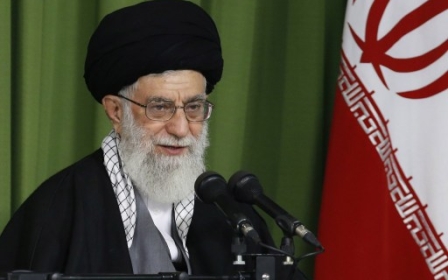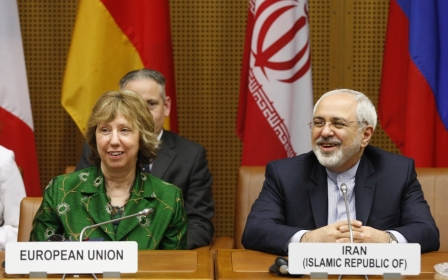Iran marks 25 years since Khomeini's death

Leading political figures and thousands of ordinary Iranians on Wednesday marked 25 years since the death of the Islamic Republic’s founder, Ayatollah Ruhollah Khomeini.
Khomeini continues to be held in awe by many in Iran, both for his role in toppling the US-backed shah Mohammad Reza in 1979 and for his stated mission of ridding Iran of what he deemed Western decadence and poisonous corruption in government.
Gatherings to commemorate his death are organised every year, with thousands of people from across Iran flocking to his Tehran shrine for the anniversary.
Early life
Khomeini was born in central Iran on 24 September, 1902, rising to become a leading Shiite scholar, or ayatollah, in the 1950s and 1960s. Khomeini produced numerous writings on Islamic philosophy, ethics and law.
He rose to fame for his advocacy of Islamic law, opposition to Mohamed Reza Shah Pahlavi - ruler of Iran at the time - and for his denunciation of Western interference and influences in Iran. He was arrested in 1962 for his active opposition of the shah regime and imprisoned for a year, after which he was exiled, living in Iraq and France.
As Iranians became increasingly disillusioned with the shah and his policies, Khomeini and his supporters began to form a strong opposition movement that eventually succeeded in toppling the shah and his family in the 1979 revolution.
Upon the shah’s overthrow, Khomeini returned to Iran, declared it an Islamic republic and was appointed as the country’s political and religious leader for life after implementing a new constitution for the Islamic Republic.
Khomeini government
Under Khomeini, Iran became an increasingly theocratic state, with the religious clergy taking over the formulation of the majority of government policies. Sharia law was introduced, Islamic dress codes were implemented, Western culture was widely discouraged and alcohol was banned.
While some Iranians welcomed this change - Islamic identity was curbed under the shah - many opposed it and fled the country.
Khomeini led a crackdown on opposition and remnants of the former regime.
A 1987 report of the United Nations Commission on Human Rights estimated that as many as 7,000 people were shot, hanged, stoned or burned to death after the 1979 revolution.
During his reign, Iran’s anti-Western policies created a huge gulf between the Islamic republic and the West, specifically the US.
US-Iran diplomatic relations were marred by the 1979 Iran hostage crisis, when students took over the US Embassy in Tehran.
Relations were further strained with the West when Khomeini offered a bounty for Salman Rushdie’s death, a British novelist who published The Satanic Verses in 1988, a book deemed blasphemous by Khomeini and other religious leaders in the Muslim world.
Although one of the key factors behind the Iranian revolution was economic disparity and while Khomeini had promised his people a better life, Khomeini’s 10-year rule did not meet people’s economic expectations.
Economically, Khomeini left Iran exhausted with his country waging a costly eight-year war with Iraq. Furthermore, since the revolution, Iran became a primary target of US sanctions and other economic pressures from the international community.
Life after Khomeini
Khomeini’s rule and war with Iraq have exerted a major influence on the internal and foreign policies of subsequent Iranian leaders.
After his death, Iran’s president and supreme religious leader became two separate positions. The republic’s supreme religious leader has been Ayatollah Ali Khamenei since 1989. While the president has executive responsibilities, the supreme leader holds constitutional authority over the executive, legislative and judicial branches of the government, including the media and the military.
When Khomeini died in 1989, Iran's economy was isolated as an aftermath of the Iran-Iraq war. The following two presidents, Akbar Hashemi Rafsanjani (president 1989 -1997) and Mohammad Khatami (1997 -2005), however, tried to situate Tehran in the international economic and political spheres.
Rafsanjani advocated a fundamental reorientation and liberalisation of the economy to try and reverse Iran’s international isolation and the next decade proved to be a period of relative economic growth and stability.
Steady economic growth in the late 1990s and early 2000s helped Iran gain more influence in the Middle East.
But the presidency of Mahmoud Ahmadinejad 2005-2013, proved to be economically troublesome, in part due to the harsh stance taken towards the nuclear issue. Under Ahmadinejad’s rule Iran also decided to throw its lot in behind embattled Syrian President Bashar al-Assad who has been fighting a more than three-year bloody civil war against his rule.
Current President Hassan Rouhani, who came to power last year and is seen as a relative reformer, continues to grapple with this legacy. With a perspective similar to Rafsanjani and Khatami, he may be able to change Iran’s international standing.
Although Iran has evolved greatly since the death of its modern founder, Khomeini’s legacy lives on in the Islamic republic most fundamental pillars of a Shiite theocracy.
Stay informed with MEE's newsletters
Sign up to get the latest alerts, insights and analysis, starting with Turkey Unpacked
Middle East Eye delivers independent and unrivalled coverage and analysis of the Middle East, North Africa and beyond. To learn more about republishing this content and the associated fees, please fill out this form. More about MEE can be found here.




